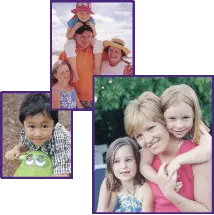|
Bedtime Doesn't Have to Be Traumatic!
How to Teach Your Child to Relax and Fall Asleep
by Patti Teel

For years our culture has underestimated the importance of sleep for adults as well as kids. But as research continues to emerge, we are finally beginning to realize that a good night's sleep is as important as proper nutrition-affecting a child's mood, immunity, and the ability to learn. In order for your child to be physically and emotionally healthy as well as a successful student, it's vital for him to get a sufficient amount of quality sleep.
Children's sleep problems are extremely common. In 2020, the National Sleep Foundation reported that a whopping 69 percent of children under the age of ten have sleep difficulties. Obviously, something is terribly wrong when more children than not have trouble sleeping. Lax rules, difficulty transitioning from the family bed, stress, over stimulation and the media are all factors that contribute to the sleep problems that children face today. Admittedly, the number of children with sleep problems is staggering. However, by improving sleep hygiene and teaching children to relax, the majority of them will be relatively easy to solve.
There are a number of parenting books on the subject of sleep, and some of them are very popular and include some sound advice. However, most of them focus on babies and they give scant attention to the most useful long term solution for children-teaching kids to purposely relax their bodies and minds so that they can relax and/or fall asleep. I am bemused when authors nonchalantly advise parents to be sure that their child falls asleep independently in his own room, without telling parents how they should accomplish this remarkable feat.
The problem is that once a child is no longer sleeping in a crib, he will be up and out of his bed. Most authors don't seem to realize that many parents are buying their book and looking for advice after having shared their bed or assisted their child to fall asleep for months or even years. When they decide that it's time for their child to fall asleep alone, reassuring, compassionate advice is not forthcoming. Instead, parents are made to feel as if they are failures-and that their child is doomed to continually have sleep problems because he didn't learn to fall asleep independently as a baby.
Continued Below
Many sleep experts warn you to expect your child to be upset for a period of time when you follow their program. Since the majority of them advise you to abruptly withdraw your attention at bedtime, with no mention of teaching a child self-soothing skills, being upset is certainly an understandable reaction. But learning to independently fall asleep does not have to be upsetting. However, expecting a child who has a sleep problem to fall asleep without first teaching him to relax is like expecting a child to read before he has learned the alphabet.
Let me offer you some reassurance. Even if your child has never fallen asleep without your assistance, it's not too late for him to become an independent sleeper and The Floppy Sleep Game Book has a program that will show you how your child can do so.
In progressive steps, the Floppy Sleep Game program will teach your child to relax themselves to sleep while you gradually and systematically decrease your attention. You teach your child many things in life and one of the most important is to relax and fall asleep independently. Best of all, this can be accomplished without trauma, tears, or tantrums. This step towards independence does not have to be a painful process for you or your child.
Children's two most frequent sleep problems are not being able to fall asleep and awakening during the night unable to fall back asleep. Brief night wakening is normal; however, once kids learn to fall asleep independently at bedtime, they will be able to fall back asleep when they briefly awaken during the night. In contrast, children who have difficulty falling asleep by themselves at bedtime usually have the same problem when they awaken during the night.
Learning self-soothing, relaxation skills will be beneficial for all children: those who have always been good sleepers, others who may have slept well as babies but developed sleep difficulties later on, as well as children who have continually struggled with sleep. In addition to enabling your child to fall asleep, relaxation skills will help children to become more resilient and capable of calmly dealing with stressful situations.
The Floppy Sleep Game Program: An Overview
Before beginning The Floppy Sleep Game program, you will be keeping a sleep journal. For one week you will be carefully observing your child and recording the information you gather. The sleep journal is important because you will be identifying any underlying problems, including habits or behaviors, which may be contributing to your child's sleep problems. Then, you will be implementing any changes you plan to make as you begin teaching your child to relax and fall asleep. If, for example, you found that your child was taking too long of a nap during the day, you would be sure that you adjust this before beginning the program. While the majority of sleep problems are behavioral, the sleep journal will help you to identify a more serious problem and your observations will help your physician to make an accurate diagnosis.
When you begin the program, it's important to take a few minutes each evening to have your child practice the three simple relaxation techniques that he will be using in the program. The three steps of The Floppy Sleep Game program consist of: guided relaxation, focused breathing and visualization. The order of the program is very important. The guided relaxation portion is first because it will help children to become calm, relaxed, and quiet enough to focus on their breathing. Children are wonderfully receptive to guided relaxation. It often helps if they are first taught to tense and then relax each of the muscle groups, a technique known as progressive relaxation. In step 2, as children focus on their breath, they will continue to become more and more relaxed. In this dreamy, relaxed state, they will be ready for step three, which is visualization. Visualization skills are enhanced through practice and eventually your child will be able to easily visualize on his own as he effortlessly drifts off to sleep.
Each week, your child will be getting less and less direction from you as they follow the three steps of the program and become more capable of relaxing themselves to sleep. During week one you will read the guided relaxation routine, the focused breathing instructions and visualization to your child, assisting him with the directions and guiding him through the process. Throughout the first week, you will continue to stay in the room as your child follows your directions, relaxes and falls asleep. You will, however, be giving less assistance throughout the week as your child becomes more adept at following your instructions.
During week two, rather than having you read the guided relaxation and focused breathing instructions, your child will be listening to it on the recording that comes with The Floppy Sleep Game Book. When it's finished, if your child is still awake, you can read them a visualization or continue with the recording.
During week 3, your child will be falling asleep without you in the room. They will either listen to The Floppy Sleep Game Book recording, or a personalized tape you have made consisting of a guided relaxation exercise, focused breathing instructions and a visualization. In week four, you will leave the room and your child will have the choice of falling asleep with or without a recording.
This system is designed for parents who want their children to fall asleep independently, in their own beds. If your child has been co-sleeping with you, be sure you are committed to this change before starting the program. If you waffle back and forth, letting your child sleep with you at times and other times not, you will probably not be successful. Start The Floppy Sleep Game program when you're well rested and dedicated to helping your child take one more step towards becoming self-reliant.
Patti Teel is the fairy godmother of peaceful bedtimes and has been dubbed "The Dream Maker" by People Magazine and "The Sleep Lady" by The Wall Street Journal. She is the creator of a highly acclaimed audio series that teaches children a fail-proof way to relax themselves to sleep through relaxation exercises (based in yoga), visualizations, music & storytelling. Her new book for parents, The Floppy Sleep Game, picks up where the recordings left off. It contains a step-by-step program for parents to follow and teach their children to relax and/or fall asleep. The techniques from The Floppy Sleep Game book also help children cope with fear and anxiety in a healthy way. You can learn more about her book and CD's at www.pattiteel.com.
|



